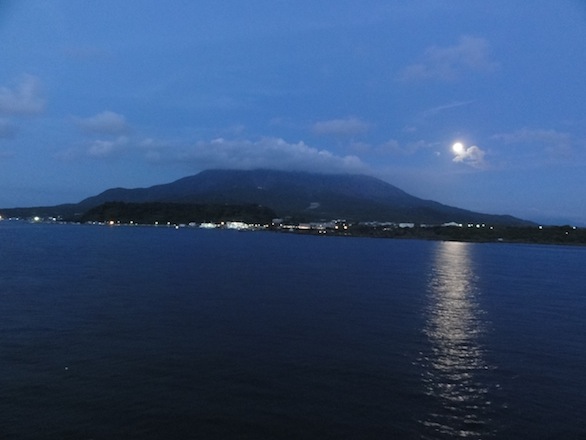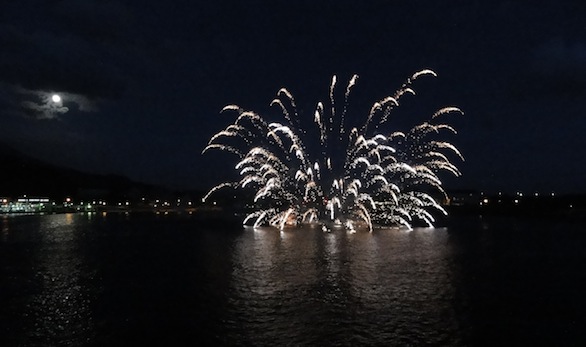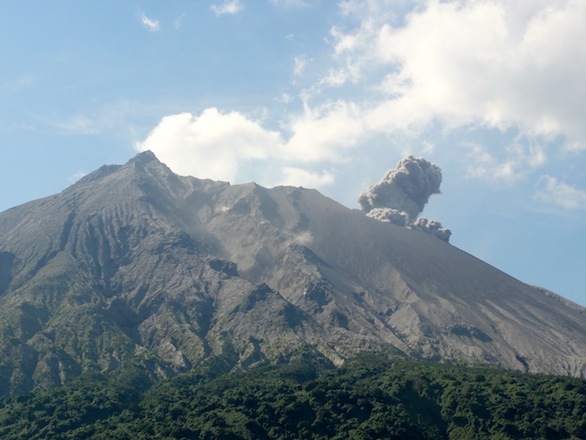KAGOSHIMA, JAPAN – It was as if the IAVCEI 2013 organizers planned it. Shortly after arriving at the Arimura lookout on the mid-conference field trip, Sakurajima began erupting.
The ash cloud rose from Showa crater, located just beyond the summit as viewed from the lookout. Part of the ash cloud ascended into the atmosphere while some of the cloud flowed along the surface in a pyroclastic density current. A pyroclastic density current is a gravity-driven movement of hot gas and volcanic material. (See this interesting twitter conversation about the difference between the terms pyroclastic density current, pyroclastic flow, and pyroclastic surge). The video below shows the initial eruption cloud as it developed.
The eruption column continued to grow as multiple pulses of ash were emitted from the crater. It wasn’t long before the cloud was carried downwind and started depositing ash.
Up until this point, the eruption was relatively quiet. Most of the sounds were caused by rockfalls and explosively ejected bombs. Then the volcano made an eerie rumbling noise as the flank began to move downslope.
You can hear the collective oohs and aahs as the volcanologists observe the eruption with reverence and awe.
At this point, we thought the show was over.

The initial eruption cloud migrating away from Sakurajima, depositing ash downwind from the volcano.
Soon after the initial pulse, the deep rumbling sounds began again, and we were treated to a second, larger blast. The ash cloud was much darker and we could see large bombs raining down near the base.
The second column reached higher in the atmosphere, up to about 3 km is what I heard from one of the volcanologists on the field trip. The volcano continued emitting pulses of black pyroclastic material and was still erupting by the time I had to leave the lookout.

A quiet Sakurajima is illuminated by the moon in our view from the post-trip gala on the ferry. (I heard there was another explosion during the party that I missed.)

The gala ended with a brilliant display of fireworks against the Sakurajima backdrop. Although the fireworks were truly spectacular, I think most of the volcanologists agreed that Sakurajima’s fireworks were the highlight of the day.
If you’re interested in seeing more photos and videos of the eruption, please check out my Google+ album or my YouTube page. Have an eruption story of your own to share? Please comment!






Oh my. Best blogpost yet!!!!
Outstanding
Excellent photos and footage, thanks for sharing!
Being a keen cyclist I decided to make my own field trip and I was lucky enough to also be there on the afternoon of 22nd. Can’t say riding a bike through the ash fall zone (of one of the earlier eruptions) was much fun though! Sadly I’d moved on a bit from Arimura when this event happened, but I got plenty of photos nonetheless – a few here if you are interested:
http://verticaljapan.blogspot.jp/2013/07/riding-sakurajima.html
I currently work with ground deformation data from Sakurajima and I was lucky enough to see the data relating to that eruption a couple of days later. Turns out it was indeed quite a big event, relatively speaking, and actually quite unusual – there looked to be two or three pulses of activity, each sending up increasingly high columns within a few minutes of each other, and this was correlated by the deformation data which shows a stepped deflation pattern rather than the usual single sudden deflation.
Such a fascinating volcano! Glad it could entertain you all during IAVCEI!
Thanks for sharing, James. Outstanding photos! It looks like you saw some amazing things on your cycling trip. Are the ground deformation data online? What might the stepped deflation mean with respect to physical processes?
mpollock: Sorry, just saw your reply! Sadly the data isn’t online – I work ‘at’ the observatory (actually my office is in Kyoto) and I looked at it directly while visiting the SVRC Observatory on Sakurajima. Truthfully I’m not (yet) sure why there was a stepped pattern. The first event was small and was perhaps only an ash ejection – the volcano clearing the conduit – although without checking the air shock records I can’t confirm this. Between the second and third events, perhaps the conduit became blocked. I don’t believe it was related to the volcano’s two current pressure sources (the very shallow Showa source and the deeper one beneath Kitadake) but without looking at all of the data again, from both monitoring stations, it’s impossible to say. I’m currently working on vast swathes of data from 2009 to 2012 so I’m rather occupied otherwise, unfortunately!
Also I have a new (rather late) post with some photos from the observatory, if you’re interested:
http://verticaljapan.blogspot.jp/2013/08/iavcei-2013-svrc.html
Apologies for the dumbed-down captions – the blog is mainly for family and friends.